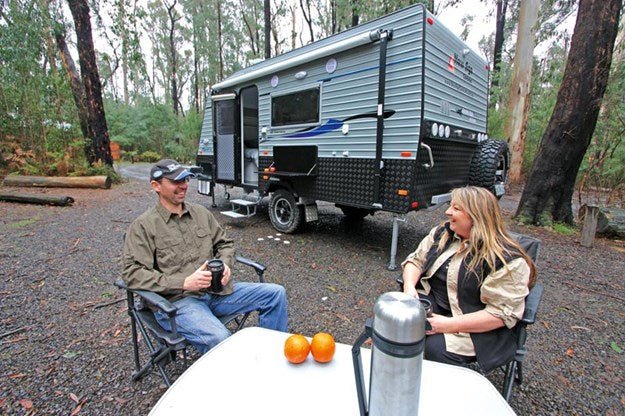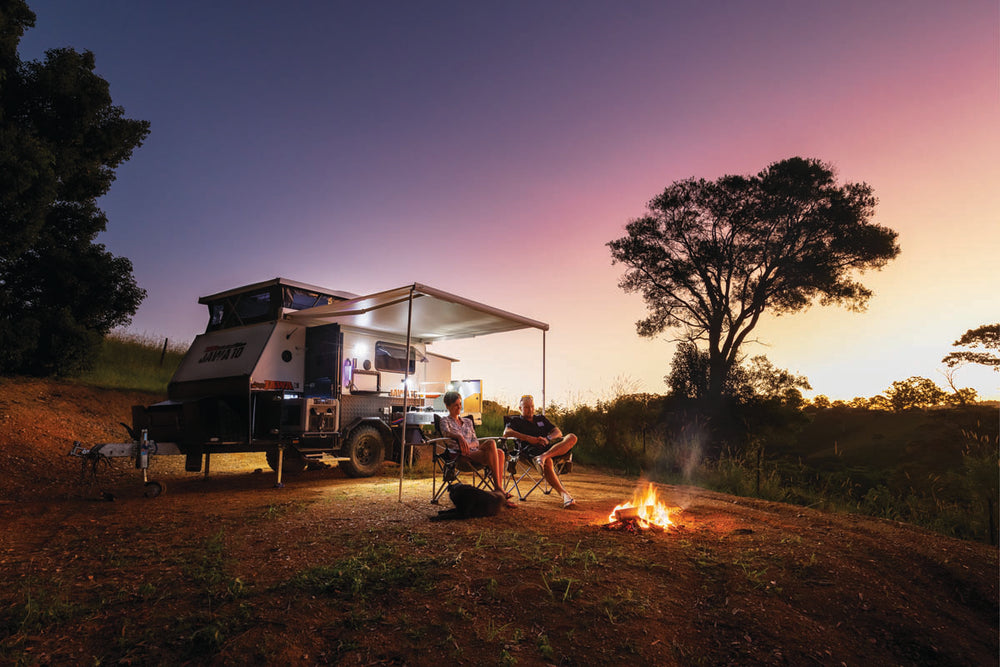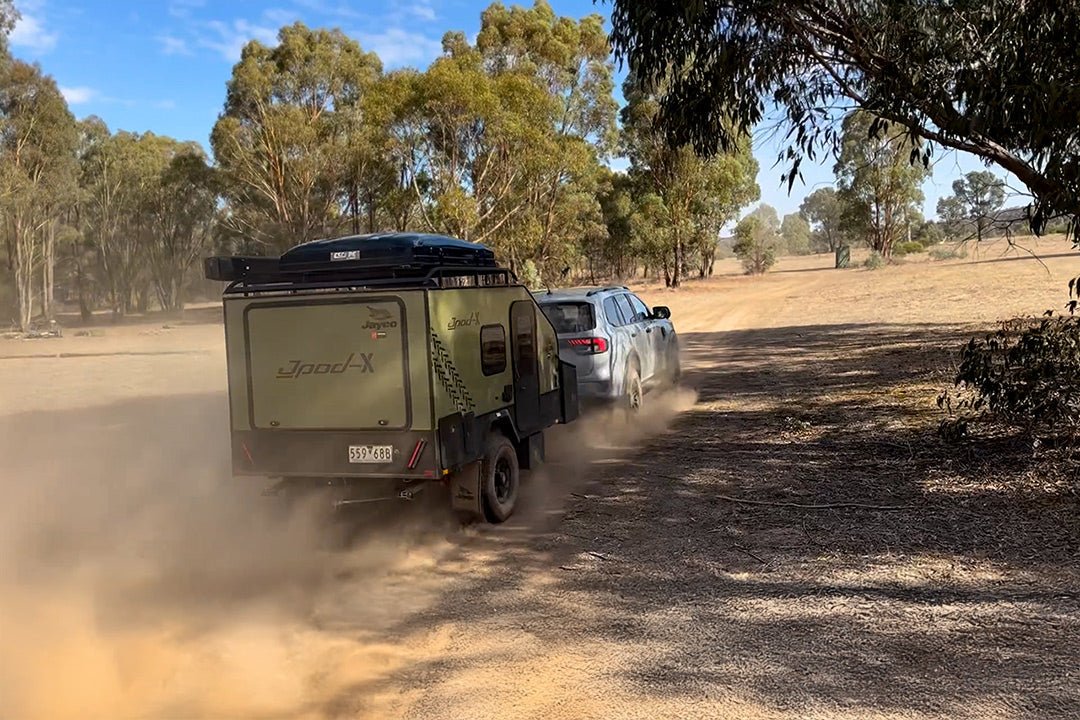Offroad RV Innovation

There’s no doubt that the Australian RV industry has begun to embrace new technologies to make caravanning safer, more tech-savvy and increasingly enjoyable. Innovation has played a key role in this shift, as we have discovered in the series of stories the Caravan World team has run on this topic over the last few months.
Innovation is somewhat of a buzzword right now. In its most basic definition, it means a shift towards out-of-the-box thinking to make processes more efficient, to find new ways to solve old problems and, in a very RV-specific sense, adapt to ever-changing ways that Aussie travellers are using their vans.
It’s often assumed that for something to be called innovative, it has to be on the same scale as inventing the smartphone or creating the next Uber. Not so. Small changes can be powerful ones, too.
One of the more exciting ramifications of innovation is the ability for caravan travellers to explore Australia in much more depth, to be able to live ‘off-grid’ and away from holiday parks and city lights for increasing amounts of time.
This means not only being able to travel farther away, but also the flexibility to stay longer, soak in the atmosphere and enjoy a very different style of holiday to what you would have been able to previously.
Many innovations are home-grown, but quite a few have been adopted from overseas. So how does the RV industry fare with innovation and what can it do better?
We posed the question to our experienced team of writers as well as several industry leaders to get their perspective on how innovative we really are, and to glean the top innovations that are making offroad adventuring much easier.
Why do we need innovation?
Colin Young, Manager of the Caravan Council of Australia, has an interesting twist on the need for innovation. He says the impetus for change is now being shaped by our desires for more luxury while on the road.
“Ground-breaking innovation has, in reality, not been deemed necessary by 'vanners — and manufacturers — over the past decades, as caravanning has been seen as a ‘roughing it’ past time, without the need for fancy mod-cons,” he says.
“The lifestyle perception nowadays has changed quite a bit, with van buyers (generally) having — and willing to spend — more money, so as to enjoy a much more-luxurious ‘home away from home’ vacation, even when miles away in the bush."
Louise Bayliss, CEO of battery chargers and power management systems company BMPRO, says innovation is win-win for both the industry and for consumers.
“As a developer of innovative products into the RV market we see that ‘innovation’ is all about how about an evolution in product development can benefit both the manufacturer and the end consumer,” Bayliss tells Caravan World.
“From the perspective of an RV manufacturer, we see that clever innovation can save time and cost in manufacturing and also, very importantly, that it enhances the customer experience which, when successful, builds a stronger brand loyalty.”
An innovation scorecard
So how well is the Australian RV sector performing in this vein? Caravan World writer and experienced RV reviewer Malcolm Street says the RV industry gets a mixed scorecard when it comes to innovation.
“In the 12V battery, charger, lighting, solar panel and inverter sector, the Australian RV market has taken it all on and in some ways, done better than the domestic/industrial market,” he says. “A big win for the RV traveller. There have also been some great developments in caravan suspension systems and towing hitches which offer a considerable variety of choice, depending on anticipated travel conditions.
“Not so good has been overall construction methods used by a considerable number of manufacturers. Australian caravans have been getting larger and heavier and whilst traditional building methods work, there has been a reluctance to move to composite body structures and move away from heavy RHS steel chassis and timber framing.”
Bayliss agrees that we could be doing it better in Australia.
“The RV industry is not a fast mover when it comes to what would be generally considered innovative,” she says. “From the outside and standard interiors that consumers are presented with, you may be forgiven for thinking that not much has changed in the last 10-15 years.
“But putting aside interior design there have been some great innovations in systems such as the BMPRO JHub digital control and monitoring system, independent suspension as seen in the JTech system, and the Cruisemaster DO35 coupling.”
Caravan World columnist Anita Pavey and her husband Mike are the co-owners of The Dirt Off Road Campers store in Adelaide, and say the RV industry is on par with other industries given its size.
“It’s not as advanced as say the motoring industry, but it’s probably relative to the volume of sales,” they say.
Rob Boegheim, Managing Director of Hema Maps, says that, with the exception of a few manufacturers, innovation in the RV industry has been lacking.
“And this is why in my view, many manufacturers are struggling to find a point of difference especially against cheaper imported product,” he says. “Customers are demanding more features at a lower price but mostly that just means more weight and higher energy usage.”
But Boegheim says there has been some great examples of forward thinking.
“The main area that has impressed me has been the fast moving shift from high quality hard floor campers to hybrids and compact offroad vans, requiring an innovative response to keep pace with fast-changing customer demand,” he says. “The RV industry has benefited from the influence of European space-saving design and materials as well as repurposing lightweight composite materials and processes from the marine industry.”
The future of RV innovation
Young says Australian manufacturers need to shift their thinking to not only cater to changing buyer needs, but also to compete against overseas companies.
“The RV industry now needs to appreciate the fast-changing and tougher market, and to act quickly in order to take advantage of the different playing field conditions, in order, not just to survive, but to flourish,” he says.
“While it is extremely difficult for Australian businesses to successfully compete with overseas companies, due to our much smaller potential market, and significantly higher material and labour costs, it is imperative that local manufacturers invest heavily in new R&D innovation projects, in order to achieve a ‘winning edge’ with (international) IP-protected products.”
Peter Quilty, Caravan World writer and reviewer, agrees with this.
“Over the past 10 years innovation has certainly played a key role within the RV industry sector but the majority of new RV innovation within Australia comes from Europe and USA RV suppliers and manufacturers,” he says. “Australian RV manufacturing is heavily dependent on labour and to survive the future they need to progressively move to less labour intensive production processes by introducing innovation to their supply chain and factory floor.
“One may ask what is the point of developing a new innovative external RV design (for example) only to find the back room production facilities to produce are behind the times.”
Innovation expert Peter Smith says manufacturing technology will continue to evolve to become something very different from what we see today.
“In the future we will enjoy the use of space-aged materials and 3D printing of spare parts while on tour."
Here we list the top 10 innovations that our experts say have contributed to a greater capacity to travel offroad,
and stay there.
1. 12V systems and battery management
The number one inhibitor to offroad sojourns in the past has been a lack of power. Unplugging from the comfort of a caravan park mean RVs need to be self-sufficient, and the area of 12V battery power and ways of keeping said batteries charged is where much innovation energy has been directed.
“The explosion of 12V technology from the likes of Setec and Ctek, and others providing the integration from solar to batteries (either AGM or lithium), and portable generation interface if required, has in some ways opened up the missing link to self-sufficiency off-grid,” says Quilty.
Collyn Rivers, author and RV expert (rvbooks.com.au), says the LiFePO4 (a chemical descriptor, not a trade name) version of lithium-based batteries is an exciting addition to the fold.
“These are about one third the size and weight of conventional rechargeable batteries, and as far more of their usable capacity can be safely exploited at (say) 100Ah, LiFePO4 is comparable to a 130Ah anything much else — some claim even more,” he says. These batteries can release bursts of power when needed.
In this vein, says Street, innovative ways to restrict the use of power in vans has also helped travellers stay offroad.
“LED lighting systems have made huge differences to energy efficiencies,” he says.
The explosion of battery management systems to monitor your power levels is also a huge boon for travellers, say Mike and Anita Pavey.
“Battery management systems take the hard work out of managing your power use,” they say. “Years ago, we relied on a volt gauge to guide us on our battery status, with 12.2V indicating low charge and that a top up was almost due. These days, we have advanced battery management systems like the Redarc Manager 30 to manage reserves, controlling all the incoming and outgoing charges.
"A simple fuel gauge display shows what’s left in the tank with an estimated remaining usage based on the existing discharge rate or an estimated refill time when the solar panels are open.”
2. Solar power
Taking advantage of the sun to top up your batteries and stay out of town for longer periods is no longer a novelty, it’s almost a given.
“Twenty years ago solar panels were a thing hippies and early adopters only could afford or understand – now they are common in most camp setups,” says Bayliss.
Most bigger rigs have several large panels, say Mike and Anita Pavey.
“Most RVs that dabble in free camping have some sort of solar to keep the batteries juiced up, and 200-300W or more is not uncommon,” they say.
“Fortunately, the price has reduced over the last 10 years or so to make it more cost effective. And with the increase in camping areas where generators are not permitted, that’s a good thing.
Rivers says the latest innovation is lightweight solar modules.
“Most 100W solar modules weigh about 10kg; some are now a mere 3kg,” he says. “There are many types of flexible solar modules, but whilst adaptable for any number of purposes they are far less efficient (about 12-14 per cent as opposed to 18-20 per cent for the top rigid units).”
3. Refrigeration
Eating out of tins and two-minute noodle packets is no longer the lot of offroad adventurers who, using their solar panels and battery systems, can power a fridge to sustain meat and fresh produce.
“We have seen refrigerator technology taken to a new level where gone are the days of dropping a large ice cube into a cool chest and hoping for the best,” says Bayliss.
“Now we have three-way and two-way fridges that can ensure the beer is always cold and the food always fresh.”
4. Offroad couplings
Towing a van safely is the highest priority, and high-tech couplings are enabling RV owners to tackle trickier terrain with more confidence and capability than ever before, especially as vans become larger and filled with all the bells and whistles for a more comfortable travelling experience.
“The ‘offroad evolution’ has spurned many local RV innovations that have enabled RV vehicles to visit and explore more of the outback than ever before in comfort and efficiency,” says Quilty.
“Offroad couplings such as AL-KO's 'Click Lock', Vehicle Components' DO35 or Treg provide the articulation connection necessary to connect the van and tow vehicle.”
5. Suspension systems
There have been great gains in independent suspension systems and many manufacturers are beginning to develop their own robust versions designed to handle rougher terrain.
Colin Young says this area is critical to the handling and stability of a towed van, both single and double axle, and is an area ripe for continued innovation.
“Variable-lift systems offer advantages, along with improvements in the ‘geometry / alignment’ of the wheels over bumps on different (smooth to very rough) road surfaces,” he says. "Other items for enhancement include improved matching of the wheels / tyres with the mass — and intended use — of the van, and better optimisation of the (combined springs and tyres) spring and damping rates.”
6. Apps and communication
The explosion of smartphone apps to gather and retain details about rest stops, fuel prices and travel info as well as information about your own rig is burgeoning. And this ever-expanding tech is also empowering RV owners who can rely less upon tradespeople to fix issues while on the road — they are more able to troubleshoot it themselves.
Bayliss says this is handing travellers more control over their adventures.
“We are seeing information and knowledge now being put into the hands of users via various technology interfaces and apps enabling them to understand what is happening with their RV,” she says.
Smith agrees that this is a great step forward and a real confidence booster to those considering more off-grid exploration.
“Remote fault and maintenance systems are a great innovation,” he says. “These include apps that allows customers to carry out care and maintenance whilst in remote areas.”
7. Toilet and shower
The days of digging your own pit toilets are, thankfully, moving behind us not only for the grubby factor, but regulations within national parks and local councils obviously don’t turn a blind eye to such things. And enjoying a ‘civilised’ hot shower in your van far from ‘civilisation’ is pretty great, says Quilty.
“To enjoy outback/off-grid touring either in a van or motorhome, the enjoyment of an on-board toilet and shower connected to a robust collection tank is sheer bliss,” he says.
8. Grey water tanks
Along these lines, grey water tanks have become an increasing inclusion into new caravans as standard and have taken leaps forward in terms of environmental protection.
“It’s not rocket science that you shouldn’t leave a puddle of water at your campsite for the next camper, but we’ve probably all done it at some time or another," say Mike and Anita Pavey.
“And just like we were educated about disposing of toilet waste, now the tide has turned towards sustainable camping and the collection of grey water.
“The innovation of grey water tanks means that bigger RVs can catch their grey water be it from the sink, shower or washing machine and dispose of it at a suitable location.”
9. Low weight and fuel efficiency
Although many experts say the RV industry could do better when it comes to using lighter materials, it has still made a lot of headway, and this has significant flow-on effects, says Smith.
“The use of modern day materials for manufacturing has reduced the weight and increased fuel efficiencies allowing longer times away from civilisation,” he says.
“The use of sustainable materials allows a win, win, win for manufacturer, client and the environment.”
Boegheim says super-strong, lightweight materials and compact design are one of his top picks.
“Those manufacturers that have innovated in this area are now the industry leaders and are benefiting from the customers' desire to move away from a big heavy van that is restricted to the bitumen to a lightweight, compact and high quality go-anywhere hybrid or compact offroad van that enables them to see and experience more off-grid places in comfort than ever before,” he says.
10. Dust and water sealing
Manufacturers are getting better at limiting dust and water ingress, says Young. Good news for the comfort of caravanners, and also for the structural integrity of your RV.
“Curved composite-panels — with improved leak-proof joins — contribute significantly to this issue, especially by not having any roof-panel joins,” he says. “A small fan system, to slightly pressurise the (filtered) air inside the van, also assists in preventing dust ingress during severe dusty driving conditions.”







